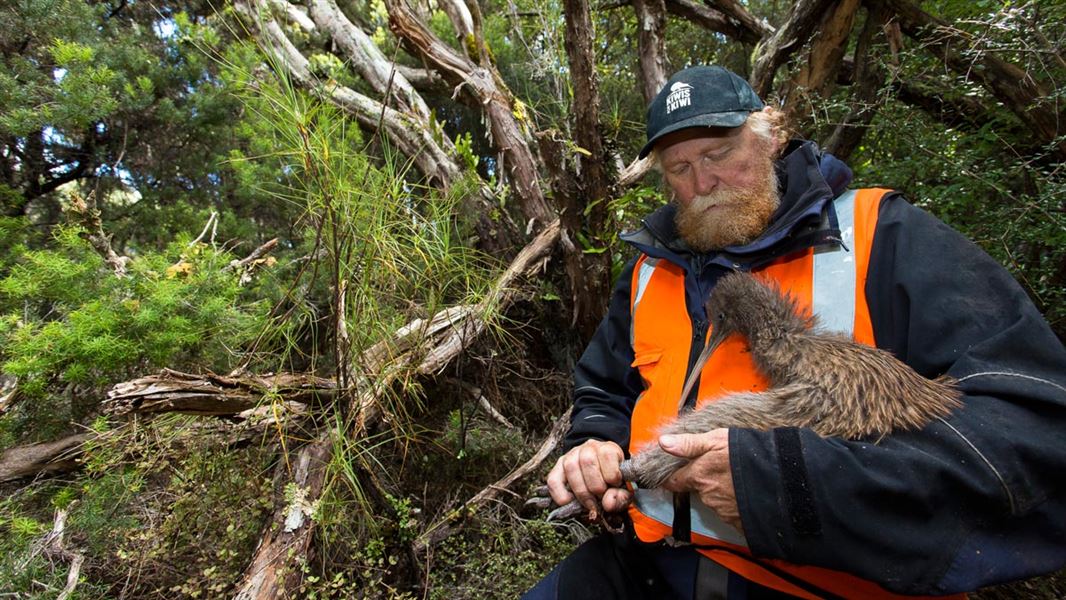The strategy for achieving this is four-fold:
- to undertake predator control in kiwi habitat;
- to continue using tools such as Operation Nest EggTM to raise chicks in captivity for release when they are ready;
- continue research into genetics, breeding, habitat requirements, monitoring techniques and landscape-scale pest control methods;
- increase help from the community and businesses, especially in areas where kiwi are found on private and production land.
Kiwi Recovery Plan 2018-2028 (PDF 1,340K)
Summary booklet about the plan:
Image gallery
Video
Kiwi sanctuaries
In 2000, DOC set up five kiwi sanctuaries aiming to increase the number of young kiwi surviving each year via predator control and to provide opportunities for research and monitoring.
There are three kiwi sanctuaries in the North Island and two in the South Island:
- Whangārei Kiwi Sanctuary (Northland brown kiwi)
- Moehau Kiwi Sanctuary on the Coromandel Peninsula (Coromandel brown kiwi)
- Tongariro Forest Kiwi Sanctuary near Taupo (western brown kiwi)
- Okarito Kiwi Sanctuary (rowi)
- Haast Tokoeka Kiwi Sanctuary (Haast tokoeka)
Successes of this management approach are being realised – for example at Whangārei, 50-60% of chicks survive their first six months compared with 11% outside of the sanctuary. At Moehau the kiwi population has doubled over ten years because of intensive management.
Save the Kiwi
Save the Kiwi has raised and distributed more than $7 million to kiwi conservation projects across New Zealand. DOC and Save the Kiwi (formerly known as BNZ Save the Kiwi Trust) have been working in partnership since 1991.
Save Our Iconic Kiwi
Save the Kiwi and DOC received significant government funding in 2015 to Save Our Iconic Kiwi.
Kiwi populations around the country are declining at an average of 2% a year – a serious situation. It’s mostly due to predation upon kiwi chicks by stoats, cats, dogs and ferrets. The goal for Save Our Iconic Kiwi is to turn this decline around, so that every type of kiwi is increasing in number.
Operation Nest Egg
Under Operation Nest Egg, kiwi eggs or chicks are taken from the wild, hatched in captivity, and raised at "crèche sites" until the juveniles reach 1 to 1.2 kg – that's when they're big enough to defend themselves from stoats. They can then be returned to the wild. Several zoos and captivity institutions are part of the programme.
An Operation Nest Egg bird has a 65% chance of surviving to adulthood – compared to just 10% for wild-hatched and raised chicks. The tool is used on all kiwi species except little spotted kiwi.
Captive management
Often the only time the public get to see a kiwi is in a nocturnal house at a captive facility. There are 15 captive facilities participating in the New Zealand captive management programme; holding around 100 brown kiwi. This is a cooperative effort between DOC and the captivity community.
Captive brown kiwi are important ambassadors for their species as they help to raise awareness about issues facing kiwi in the wild. The captive population is managed sustainably so that it may also provide kiwi to supplement wild populations as required. It also has a role in supporting some aspects of kiwi research. These include trialling radio-transmitters on captive birds, and utilising management techniques that increase our scientific knowledge of this intriguing bird.
Kiwi call count monitoring
DOC has a formal kiwi call monitoring programme, run as part of Kiwis for kiwi. The work involves sitting in the bush and listening for two hours over four nights at each station.
Radio tracking, footprint size recording and surveys using specially trained dogs to find kiwi may also be used at various sites.
